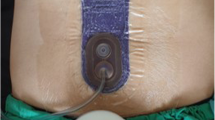Abstract
Immune compromised as well as critically ill patients are at higher risk of surgical wound infection and dehiscence. Wound infections critically influence the outcomes after liver transplantation. In particular, it was shown that they significantly reduce the overall survival rate when compared to patients with uneventful wound healing, and their occurrence is associated with death or graft loss within 1-year post-transplantation. From January 2001 through December 2017, 763 patients underwent liver transplantation in our Institution, the Hepato-Pancreato-Biliary Surgery and Liver Transplantation Unit, “Policlinico” University Hospital, University of Modena and Reggio Emilia, Modena, Italy. We retrospectively analyzed data from our prospectively maintained database of patients treated with a negative pressure therapy device due to wound or abdominal infections. 13 patients underwent negative pressure treatments for surgical site infection after liver transplantation in our institution. Ten superficial “supra-fascial” applications (SF group) and three deeper abdominal (Ab group) were reported. Mean in-hospital stay for the SF group was 42.6 days, ranging from 8 to 80, while for the Ab group was 62 days (range 23–133), with an overall survival of 34 and 4.6 months, respectively. A multifactorial multidisciplinary approach is needed in the prevention of surgical site infections instead of mere antimicrobial prophylaxis The application of negative pressure wound therapy may help in controlling the diffusion of the infection and preventing sepsis.

Similar content being viewed by others
References
Pignatti M et al (2013) Treatment of wounds colonized by multidrug resistant organisms in immune-compromised patients: a retrospective case series. Patient Saf Surg 7(1):28
Fishman JA (2011) Infections in immunocompromised hosts and organ transplant recipients: essentials. Liver Transpl 17(Suppl 3):S34–S37
Humar A et al (2001) Are wound complications after a kidney transplant more common with modern immunosuppression? Transplantation 72(12):1920–1923
Cockbain AJ et al (2010) The impact of postoperative infection on long-term outcomes in liver transplantation. Transpl Proc 42(10):4181–4183
Hellinger WC et al (2009) Surgical site infection after liver transplantation: risk factors and association with graft loss or death. Transplantation 87(9):1387–1393
Assirati G et al (2016) Vacuum-assisted closure therapy in patients undergoing liver transplantation with necessity to maintain open abdomen. Transpl Proc 48(2):383–385
Demetriades D, Salim A (2014) Management of the open abdomen. Surg Clin North Am 94(1):131–153
Acosta S et al (2011) Multicentre prospective study of fascial closure rate after open abdomen with vacuum and mesh-mediated fascial traction. Br J Surg 98(5):735–743
Almeida RA et al (2015) Antibiotic prophylaxis for surgical site infection in people undergoing liver transplantation. Cochrane Database Syst Rev 12:CD010164
Garcia Prado ME et al (2008) Surgical site infection in liver transplant recipients: impact of the type of perioperative prophylaxis. Transplantation 85(12):1849–1854
Gurusamy KS, Nagendran M, Davidson BR (2014) Methods of preventing bacterial sepsis and wound complications after liver transplantation. Cochrane Database Syst Rev 3:CD006660
Avkan-Oguz V et al (2013) Risk factors for early bacterial infections in liver transplantation. Transpl Proc 45(3):993–997
Asensio A et al (2008) Effect of antibiotic prophylaxis on the risk of surgical site infection in orthotopic liver transplant. Liver Transpl 14(6):799–805
Hellinger WC et al (2011) Association of surgeon with surgical site infection after liver transplantation. Am J Transplant 11(9):1877–1884
Zanus G, Boetto R, D’Amico F, Gringeri E, Vitale A, Carraro A, Bassi D, Scopelliti M, Bonsignore P, Burra P, Angeli P, Feltracco P, Cillo U (2011) A novel approach to severe acute pancreatitis in sequential liver-kidney transplantation: the first report on the application of VAC therapy. Transplant International 24 (3):e23–e27
Dondossola D et al (2015) Negative pressure wound treatment of infections caused by extensively drug-resistant gram-negative bacteria after liver transplantation: two case reports. Transpl Proc 47(7):2145–2149
Hobeika C et al (2017) Management of the open abdomen after liver transplantation. World J Surg 41(12):3199–3204
Chan T, Bleszynski MS, Youssef DS, Segedi M, Chung S, Scudamore CH, Buczkowski AK (2018) Open abdomen in liver transplantation. The American Journal of Surgery 215 (5):782–785
Peinemann F, Sauerland S (2011) Negative-pressure wound therapy: systematic review of randomized controlled trials. Dtsch Arztebl Int 108(22):381–389
Peinemann F, Sauerland S (2011) Effectiveness of negative pressure wound therapy is still unproven. J Wound Care 20(2):88
Author information
Authors and Affiliations
Contributions
PM and FDB: study concept and design. TO and GT: literature review. VS and GA: data analysis. PM, RB and AP: manuscript drafting. RB, AP and FDB: critical revision.
Corresponding author
Ethics declarations
Conflict of interest
All authors have seen and approved the manuscript and are fully conversant with its contents. None of the authors has personal, financial or political interest in the material.
Research involving human participants and/or animals
This article does not contain any studies with human or animal subjects performed by any of the authors.
Informed consent
For this type of study formal consent is not required.
Rights and permissions
About this article
Cite this article
Magistri, P., Olivieri, T., Serra, V. et al. Vacuum-assisted management of surgical site infections after liver transplantation: 15-year experience in a tertiary hepatobiliary center. Updates Surg 71, 457–462 (2019). https://doi.org/10.1007/s13304-018-0583-8
Received:
Accepted:
Published:
Issue Date:
DOI: https://doi.org/10.1007/s13304-018-0583-8




